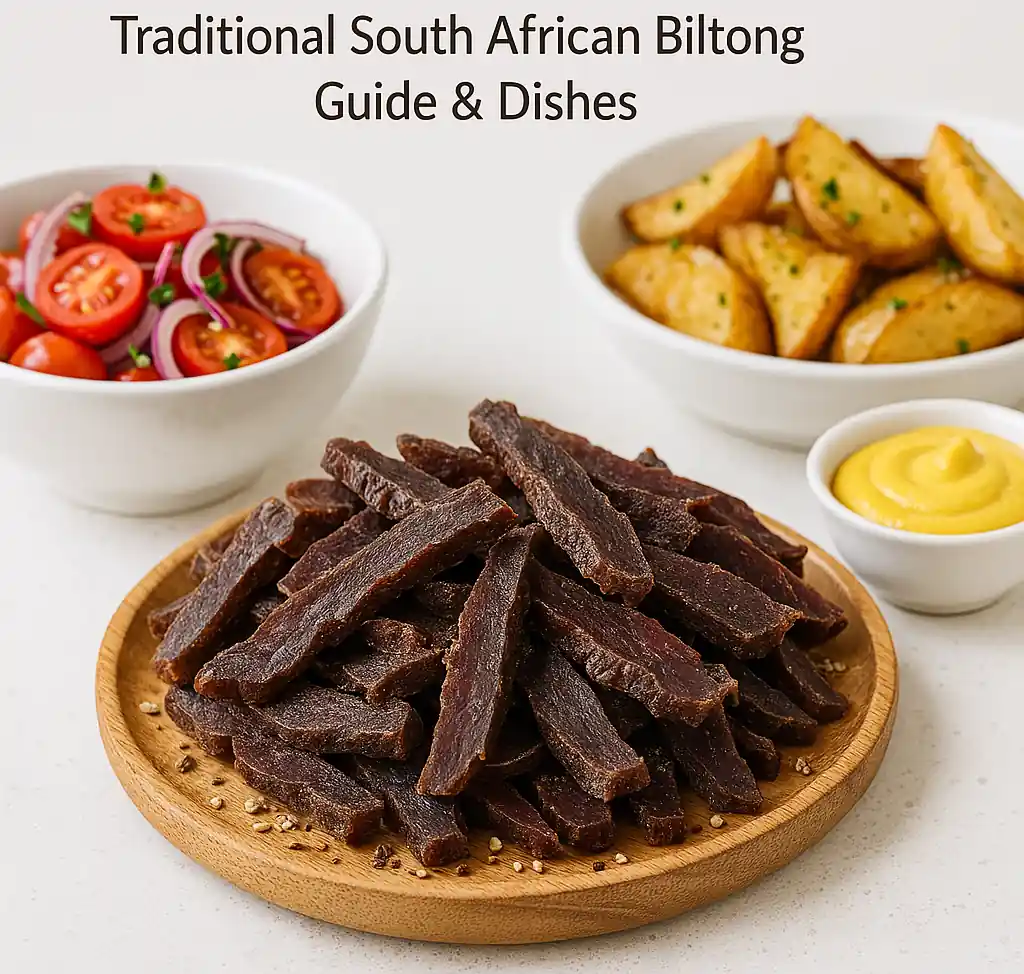Biltong Food Recipes: A Deep Dive into African Tradition and Flavor
What Is Biltong?
Biltong is a traditional South African dried meat delicacy, often compared to beef jerky, but with a deeper, more robust flavor and unique preparation method. The word “biltong” originates from the Dutch words bil (buttock) and tong (strip or tongue), referencing the way the meat is cut. It is popular across Southern Africa and is gaining traction globally for its high protein content, rich taste, and long shelf life.
Understanding the History of South African Biltong
The origins of biltong trace back centuries to indigenous South African tribes who preserved meat using salt and drying techniques. The method was further refined by European settlers, particularly Dutch colonists, who introduced vinegar and spices such as coriander and black pepper. Biltong became an essential staple, especially during long journeys across the rugged African landscape.
According to the South African History Online, this preservation method was critical for survival and evolved into a beloved food tradition.
Biltong vs. Jerky: What’s the Difference?
While both are dried meats, the difference lies in their preparation:
- Beef jerky is typically marinated in sauces and smoked or dehydrated.
- Biltong is cured in vinegar and spices, then air-dried slowly over several days.
The result is a product with a different texture and taste profile. Biltong tends to be more tender and retains the flavour of the beef, whereas jerky is usually tougher and flavored through marinades.
Types of Meat Used to Make Biltong
Traditionally, silverside or topside beef cuts are used due to their leanness and grain structure. However, modern recipes also include:
- Game meats (such as kudu or ostrich)
- Chicken
- Pork
- Venison
Each meat type brings its own texture and taste. Home biltong makers often experiment to find the best biltong flavour for their palate.
Ingredients for the Best Biltong Recipe
To make biltong at home, you’ll need:
- 2 kg of silverside beef
- 30 ml of brown vinegar (or salt and vinegar mixture)
- 15 g coriander seeds (toasted and crushed)
- 10 g black pepper (freshly ground)
- 15 g salt
- Optional: chilli flakes, worcestershire sauce, or other spices
The key to the ultimate South African flavour is the method and spice mix, which includes toasting whole coriander seeds in a pestle and mortar to release oils for flavour.
Step-by-Step Guide to Make Biltong at Home
Step 1: Prepare the Meat
- Remove the meat from packaging and pat dry.
- Slice along the grain of the meat, about 2 cm thick strips.
- Trim off visible fat to avoid rancidity during the drying process.
Step 2: Apply the Cure
- Mix salt, black pepper, and crushed coriander seeds.
- Rub the spice blend generously over the meat.
- Add vinegar and Worcestershire sauce to aid curing and kill bacteria.
- Cover and store it in the fridge for a few hours to let the flavours penetrate.
Step 3: Drying the Biltong
- Use a biltong box, food dehydrator, or hang the meat in a well-ventilated space.
- Maintain steady airflow to prevent mould.
- Drying can take 4 to 7 days depending on air circulation, humidity, and meat thickness.
According to Serious Eats, ideal drying temperature is around 22°C (72°F).
The Science of the Drying Process
The contraction of the proteins during drying changes the meat’s structure, concentrating its flavour. Bicarbonate of soda is sometimes added to soften the meat and balance acidity. The drying also enhances the umami notes and creates that iconic caramel and molasses flavour found in delicious biltong.
South African Style Biltong: Cultural Significance
South African biltong isn’t just food—it’s a national pride, often shared at social gatherings, braais (barbecues), and sports events. It’s embedded in tradition, reflecting the ingenuity of African food preservation. The traditional South African preparation method still guides modern recipes.
Homemade Biltong Tips
- Create good air circulation: Use fans or vents in DIY setups.
- Use a biltong maker or biltong box for consistency.
- Always toast the coriander seeds before use.
- Monitor saltiness—amount of salt can overpower if not balanced.
- Pack the biltong in breathable paper or vacuum seal after drying.
For a detailed guide on DIY methods, refer to Instructables.
Biltong Salad Ideas
Biltong Salad
A refreshing way to enjoy shredded biltong is in a crisp salad. Combine:
- Mixed greens
- Cherry tomatoes
- Sliced avocado
- Shredded biltong
- Crumbled feta
- Olive oil and vinaigrette
Add a handful of toasted sunflower seeds for crunch. The salty richness of biltong complements fresh ingredients beautifully.
Biltong and Cheese Quiche
This biltong and cheese quiche is a protein-rich twist on a classic:
- Use puff pastry as the base.
- Add a mix of dry biltong and shredded cheddar.
- Pour over a blend of eggs and cream.
- Bake until golden and set.
This quiche offers a great recipe to repurpose leftovers.
Biltong Soup Recipe
Biltong Soup
South African winters call for hearty soups, and biltong soup fits the bill:
- Start with a base of onions, garlic, and butter.
- Add chopped biltong, cream, and stock.
- Simmer until thickened.
The rich, meaty flavor makes it ideal as a winter comfort dish. For more recipes, check out Taste Magazine.
Biltong Stuffed Peppers
Biltong Stuffed
Create a protein-packed snack:
- Hollow out bell peppers
- Stuff with a mix of cream cheese, herbs, and shredded biltong
- Grill until soft and bubbly
It’s ideal for game-day snacks or party platters.
Biltong Fried Rice
A fusion dish, biltong fried rice includes:
- Day-old rice
- Scrambled eggs
- Veggies (like peas, carrots, onions)
- Powdered biltong for seasoning
- Soy sauce and garlic
This dish showcases how many recipes can include biltong without overpowering the base flavors.
Using Toast and Biltong Together
Toast the coriander, add avocado, and top with shredded biltong. This open-face sandwich is perfect for breakfast or a light lunch.
Chilli Biltong for Spice Lovers
Chilli
Add chilli flakes to the spice rub during curing. The heat balances well with the salt and freshly ground black pepper to create a bold taste.
Storing Your Biltong Safely
- Once dry, store it in the fridge in a paper bag to absorb moisture.
- Vacuum sealing is great for longer shelf life.
- Avoid plastic if condensation is a risk.
According to University of Nebraska Food Safety, dried meat should be stored in cool, dry conditions to reduce bacterial growth.
Biltong Every Day? Yes!
Biltong lovers often use it as:
- A gym snack
- A topping on pasta or pizza
- A quick protein bite between meals
The versatility of biltong makes it easy to incorporate into everyday meals.
Tried Your Recipe? Share It!
Have you tried your recipe at home? Let others know how it turned out. Tag your creations or comment on recipe forums like The Fresh Loaf.
Final Thoughts on the Biltong Experience
From the biltong flavour crafted by traditional methods to modern dishes like biltong soup and biltong and cheese quiche, this dried meat continues to inspire home cooks. Whether you’re using a biltong maker, food dehydrator, or a simple box with a fan, anyone can learn how to make biltong at home.
This journey into ultimate South African cuisine reveals how one humble method of meat preservation became a national treasure and a global snack trend.

